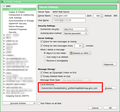
Can you delete old imap files
Yesterday I ran a virus scan on my PC. It flagged the file mobile.charter-6.net and told me to delete it. After looking at the folder, that contained this file, I decided to delete it. I have attached an image of the folder that contained the file. There are multiple mobile.charter files. Can these be deleted? Is there a procedure to cleanup old files? Why are there so many?
I have three email accounts. Can I delete the email accounts, delete the imap files, and create the email accounts again?
If you notice in the image there are two imap files for gmail and two for outlook. I had a problem, which as it turns out was not caused by Thunderbird, but I ended up deleting the email accounts and re-configuring. I had a problem, not related to Thunderbird, where the vendor wanted me to uninstall my security suite. When I did that it caused a problem with Thunderbird. When I reconfigured the email accounts that problem disappeared. I think that was on 3/20/18.
Chosen solution
Check the "Local directory" setting in each account. That will tell you which storage folder is actually in use.
In general, when you select an account for deletion, its data is retained but hidden from view. If you were then to set up the same account again, since the folder name used to store your messages is based on the server name, it would have the same name as the previous installation, so the numerical suffix would be automatically added to differentiate it.
So for the gmail and outlook accounts, the second folder is to be expected. The question here is why there are so many charter.net folders. Note that nine of them were last accessed (and possibly created) on the same day, so I'd guess something drastic happened on that day.
mobile.charter-12.net appears to be the latest (current?), judging by its datestamp, so the existence of mobile.charter-13.net is a bit of a mystery.
Since IMAP saves messages on the server, I'd say you can safely delete all the older folders - but check against what each Local directory setting says, to be absolutely sure which folders are currently in use. This will avoid you having to download all your messages again.
For each folder that delete, you can also delete the associated .msf file.
Read this answer in context 👍 1All Replies (3)
Chosen Solution
Check the "Local directory" setting in each account. That will tell you which storage folder is actually in use.
In general, when you select an account for deletion, its data is retained but hidden from view. If you were then to set up the same account again, since the folder name used to store your messages is based on the server name, it would have the same name as the previous installation, so the numerical suffix would be automatically added to differentiate it.
So for the gmail and outlook accounts, the second folder is to be expected. The question here is why there are so many charter.net folders. Note that nine of them were last accessed (and possibly created) on the same day, so I'd guess something drastic happened on that day.
mobile.charter-12.net appears to be the latest (current?), judging by its datestamp, so the existence of mobile.charter-13.net is a bit of a mystery.
Since IMAP saves messages on the server, I'd say you can safely delete all the older folders - but check against what each Local directory setting says, to be absolutely sure which folders are currently in use. This will avoid you having to download all your messages again.
For each folder that delete, you can also delete the associated .msf file.
Thanks for the information.
Just for your information I was trying to find local folder. The graphic did not come through the email. I found it when I went to respond to ask where to find the local folder.
The reason there is a mobile.charter-12.net and a mobile.charter-13.net is because I have two charter email addresses. Instead of three email accounts I have four.
I accidentally deleted the 13.msf file. Is that a problem. I have the file because I performed a backup prior to deleting any files.
It turns out that my virus was actually malware associated with MS Word. Fortunately I never click on anything unless I am sure what it is and I had deleted the email. The software found the malware in the Trash folder when I performed a scan.
Generally speaking, you don't need to preserve msf files. They act as indexes and caches for message status, but if you delete one it will be silently and automatically recreated. You may lose some settings such as personalised column arrangements in the message list.
Deleting msf files can be a useful shortcut to get folders "repaired", and doing this can be a lot more efficient then entering each folder's properties page to repair it, if you want to repair multiple folders.


